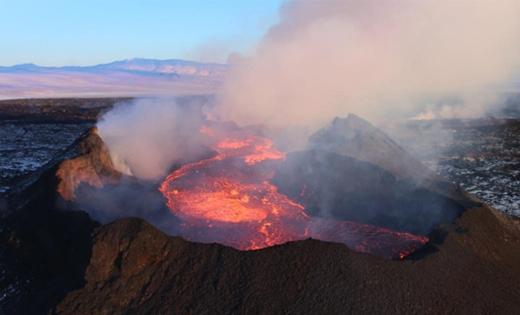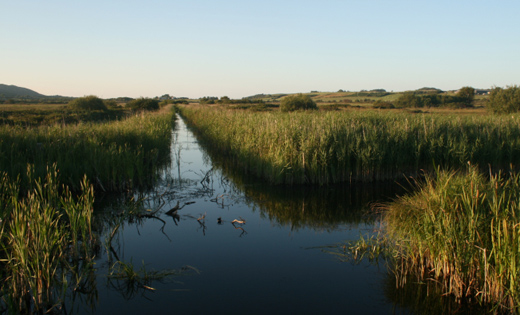Research Round-up – April 2021
Welcome to the latest instalment of our monthly feature series throwing the spotlight on our research success stories.
The strength of our research is in making a real and telling difference to the world around us, by working across traditional boundaries to find innovative solutions to some of the greatest challenges facing society today.
Here we highlight some of latest projects being pioneered by the expertise and efforts of the highly talented research community at Leeds.
From grant awards to examples of outstanding interdisciplinary work and best practice, we’re keen to showcase your research achievements. See the foot of this article for details of how you can get involved.
Featured in this month’s round-up:
- Volcanic pollution link to respiratory disease increase
- Energy unleashed by submarine volcanoes could power a continent
- Weather forecasts that predict meningitis outbreaks
- Managing peatlands to cut greenhouse gas emissions
- Wellcome funding for medical humanities
- Northern universities launch new investment company
- Leeds signs up to tackle waste in fashion
- Inspired by nature – research to develop a new load-bearing material
- Artificial Intelligence could create better outcomes for bowel cancer patients
- How to feature in future research round ups

The new research led by Leeds examines the health impacts of volcanic pollution on respiratory diseases
Volcanic pollution link to respiratory disease increase
Respiratory disease increased markedly following one of Iceland’s largest volcanic eruptions, a new study has found.
The findings could have significant implications for actions taken to protect the health of the 800 million people living near active volcanoes. Only last month, lava burst through a crack in Iceland’s Mount Fagradalsfjall in the first eruption of its type for more than 800 years.
The new research, led by Leeds and the University of Iceland, examined the health impacts of pollution caused by the Holuhraun lava eruption in 2014-2015.
It showed that, following exposure to emissions that changed chemically from gas to fine particles, incidents of respiratory disease in Iceland rose by almost a quarter, and the incidence of asthma medication dispensing by a fifth.
The findings highlight the need for decision-making authorities to prepare for health issues associated with returning emissions – known as mature plumes – in the days immediately following volcanic eruptions.
The report’s co-lead author, Dr Evgenia Ilyinskaya, from the School of Earth and Environment, said: “Volcanoes are a significant source of air pollution but, of course, it’s a source that cannot be controlled.
“Large volcanic eruptions can cause harmful air pollution both immediately, and also when the plume returns to the same area, which may happen without it triggering air pollution alerts.”
In their previous research, published in 2017, the scientists traced the evolution of the volcanic plume chemistry. They found that the plume had been swept by air currents towards the UK and mainland Europe before circling back to Icelandic cities and towns.
During this process, the plume composition matured as it lingered in the atmosphere – meaning that the volcanic sulphur dioxide had converted to particles.
These fine particles found in mature plumes are so small they can penetrate deep into the lungs, potentially causing serious health problems, such as exacerbating asthma attacks.

Eruptions from deep-sea volcanoes were long-thought to be relatively uninteresting compared with those on land
Energy unleashed by submarine volcanoes could power a continent
Volcanic eruptions deep in our oceans are capable of extremely powerful releases of energy – at a rate high enough to power the whole of the United States, according to research published today.
Eruptions from deep-sea volcanoes were long-thought to be relatively uninteresting compared with those on land. While terrestrial volcanoes often produce spectacular eruptions, dispersing volcanic ash into the environment, it was thought that deep marine eruptions only produced slow-moving lava flows.
But data gathered by remotely operated vehicles deep in the North East Pacific, and analysed by scientists at Leeds, has revealed a link between the way ash is dispersed during submarine eruptions and the creation of large and powerful columns of heated water rising from the ocean floor, known as megaplumes.
These megaplumes contain hot chemical-rich water and act in the same way as the atmospheric plumes seen from land-based volcanoes, spreading first upwards and then outwards, carrying volcanic ash with them. The size of megaplumes is immense, with the volumes of water equivalent to forty million Olympic-sized swimming pools. They have been detected above various submarine volcanoes, but their origin has remained unknown. The results of this new research show that they form rapidly during the eruption of lava.
The research was carried out by Dr Sam Pegler, from the School of Mathematics, and Dr David Ferguson, from the School of Earth and Environment.
Together, they developed a mathematical model that shows how ash from these submarine eruptions spreads several kilometres from the volcano. They used the ash pattern deposited by an historic submarine eruption to reconstruct its dynamics. This showed that the rate of energy released and required to carry ash to the observed distances is extremely high – equivalent to the power used by the whole of the USA.

The initiative led by Leeds can warn if a meningitis outbreak is likely to become an epidemic
Weather forecasts that predict meningitis outbreaks
Scientists are using weather forecasts to predict the location and scale of impending meningitis outbreaks in sub-Saharan Africa.
It’s part of an early-warning system being piloted with the aim of giving health agencies more time to activate emergency response plans.
The approach – pioneered by ACMAD, the African Centre of Meteorological Applications for Development, and the African SWIFT initiative led by Leeds and the National Centre for Atmospheric Science – is using weather data to give up to two weeks’ advanced warning of conditions ‘less likely’ or ‘highly likely’ to trigger a meningitis outbreak.
The forecasts also warn if an outbreak is likely to become an epidemic.
Meningitis is an infection of the membrane surrounding the brain and spinal column, and incidence of the disease rises dramatically in hot, dry and dusty weather. There are about 30,000 cases in Africa each year: one in ten infected people die, and others can be left with brain damage, epilepsy and deafness.
Dust particles can irritate people’s airways and allow airborne microorganisms to get into the body and cause a meningitis infection. Once an outbreak starts, it spreads rapidly from person to person.
Professor Doug Parker, lead scientist at African SWIFT, said: “We are in the middle of the African meningitis ‘season’ and so can assess how effective the specialised weather forecasts are in helping to better coordinate health action on the ground.”

Agricultural peatlands store carbon and support unique biodiversity
Managing peatlands to cut greenhouse gas emissions
Substantial cuts in global greenhouse gas emissions could be achieved by raising water levels in agricultural peatlands, according to a new study.
Peatlands occupy just three per cent of the world’s land surface area but store a similar amount of carbon to all terrestrial vegetation, as well as supporting unique biodiversity.
In their natural state, they can mitigate climate change by continuously removing carbon dioxide (CO2) from the atmosphere and storing it securely under waterlogged conditions for thousands of years. But many peatland areas have been substantially modified by human activity, including drainage for agriculture and forest plantations.
This results in the release of the equivalent of about 1.5 billion tonnes of CO2 into the atmosphere each year, which equates to three per cent of all global greenhouse gas (GHG) emissions caused by human activities.
A research team, including scientists from Leeds, studied CO2 emissions in 16 peatland areas and methane emissions in 41 peatland areas across the British Isles, along with data from other countries, and estimated the potential reduction in emissions by restoring all global agricultural peatlands.
However, because large populations rely on these areas for their livelihoods, it may not be realistic to expect all agricultural peatlands to be fully rewetted and returned to their natural condition in the near future.
The team therefore also analysed the impact of halving current drainage depths in croplands and grasslands on peat – which cover more than 250,000 km² globally – and showed that this could still bring significant benefits for climate change mitigation. The study estimates this could cut emissions by about 500 million tonnes of CO2 a year, which equates to one per cent of all global GHG emissions caused by human activities.

Leeds researchers have secured £1 million in funding to develop medical humanities research
Wellcome funding for medical humanities
A team from the Faculty of Arts, Humanities and Cultures has secured £1 million in funding from global charitable foundation Wellcome to develop medical humanities research.
The three-year development grant will be used to further understand the relationship between the human body and technologies associated with health and disability, as part of a project called LivingBodiesObjects: Technology and the Spaces of Health.
Professor Stuart Murray, Director of the Leeds Centre for Medical Humanities, is joint leader of the research, alongside Dr Clare Barker and Dr Amelia DeFalco in the School of English, Dr Tom Jackson in the School of Media and Communication, Professor James Stark in the School of Philosophy, Religion and History of Science, and Faye Robinson from the University’s Research and Innovation Service.
Professor Murray said: “This award was open to academics across the world and it is a very significant achievement to have been successful.
“It would not have been possible without the dedication and hard work of colleagues and the inspiration of our students.
“The Leeds team will work with creative facilitators Immersive Networks and develop a series of six-month residencies with an inspiring group of external partners – the Bhopal Medical Appeal and the Remember Bhopal Museum, Blueberry Academy, Interplay Theatre and the Thackray Museum of Medicine.”
Medical humanities research at Leeds brings together researchers who work on a broad range of topics across the interaction between literature, history, culture and medicine and health.

The company will fund spinout enterprises - helping to tackle some of the world's biggest challenges
Northern universities launch new investment company
The Universities of Leeds, Manchester and Sheffield are launching a new investment company to help boost the commercialisation of university spinouts and start-ups in the North of England.
The company, Northern Gritstone, will fund spinout enterprises from each institution using external capital raised from a range of different investors. These businesses will either be newly formed spinouts or ones historically founded by, or linked to, the universities. The company also aims to be a key part of the Government’s ‘Build Back Better’ levelling-up agenda and Plan for Growth in the North.
The three universities initially came together in 2018 to create the Northern Triangle Initiative and secured a £5 million award from the Research England Connecting Capabilities Fund (CCF). By 2020, the CCF had supported about 20 commercially viable projects, substantially improving commercialisation rates across the three universities and generating a sustainable pipeline of university spinouts.
Northern Gritstone will build on this successful collaboration by providing significant start-up and follow-on funding to support the Intellectual Property developed at Leeds, Manchester and Sheffield. Northern Gritstone plans to raise up to £500 million from strategic corporate partners, institutional investors and qualifying individuals. If successful, the financing will make Northern Gritstone one of the largest dedicated investors into the commercialisation of university science and technology related Intellectual Property in the UK.
Northern Gritstone will provide funding for a diverse range of companies across areas such as advanced materials and manufacturing, health and life sciences, artificial intelligence and data sciences.

Leeds is the first university to sign up to a voluntary agreement that aims to transform the UK's fashion culture
Leeds signs up to tackle waste in fashion
Leeds is the first university to sign up to a voluntary agreement to slash the impact of the UK clothing and home fabrics industries on the environment.
Operating in line with the Paris Agreement and the UN Fashion Industry Charter for Climate Action, the initiative will have a global impact.
Textiles 2030 aims to transform the UK’s make-use-dispose fashion culture into one where products are made sustainably, used longer and then reused or recycled.
Backed by Government, signatories include John Lewis, Primark, Sainsbury’s and Marks and Spencer.
Dr Mark Sumner, Lecturer in Sustainability, Fashion and Retail in the School of Design, has been appointed to the advisory board for the initiative. He said: “We are incredibly proud to be the first university to sign up as an affiliate to Textiles 2030.
“The School of Design leads the sector in addressing urgent issues around sustainability in textiles, including pioneering initiatives such as Future Fashion Factory, which bring together industry partners, technology and researchers to help inform – and transform – manufacturing practice.”
Dr Sumner – one of several sustainability experts in the school – spent more than 15 years working for the UK’s largest clothing retailer, and was a consultant for brands, retailers and industry bodies.
He made a major contribution to the House of Commons’ Environmental Audit Committee report on Fixing Fast Fashion last year, and is currently engaged in research exploring the impacts of the covid pandemic on the UK industry and workers in the supply chain.

The research team believes a cartilage-like material would have a wide-range of uses across engineering
Inspired by nature – research to develop a new load-bearing material
Engineers have developed a material that mimics human cartilage – the body’s shock absorbing and lubrication system.
And it could herald the development of a new generation of lightweight bearings.
Cartilage is a soft, fibrous tissue found around joints that provides protection from the compressive loading generated by walking, running or lifting. It also provides a protective, lubricating layer allowing bones to pass over one another in a frictionless way.
For years, scientists have been trying to create a synthetic material with the properties of cartilage. To date, they’ve had mixed results.
Researchers at Leeds and Imperial College London have announced they’ve created a material that functions like cartilage.
The research team believes a cartilage-like material would have a wide-range of uses across engineering.
Cartilage is a bi-phasic porous material, meaning it exists in solid and fluid phases. It switches to its fluid phase by absorbing a viscous substance produced in the joints, called synovial fluid. This fluid not only lubricates the joints, but when held in the porous matrix of the cartilage, it provides a hydroelastic cushion against compressive forces.
Because the cartilage is porous, the synovial fluid eventually drains away, and as it does, it helps dissipate the energy forces travelling through the body, protecting joints from wear and tear and impact injuries. At this point, the cartilage returns to its sold phase, ready for the cycle to be repeated.
Dr Siavash Soltanahmadi, Research Fellow in the School of Mechanical Engineering, who led the research, said: “Scientists and engineers have been trying for years to develop a material that has the amazing properties of cartilage.
“We have now developed a material for engineering applications that mimics some of the most important properties found in cartilage, and it has only been possible because we have found a way to mimic the way nature does it.”

Leeds researchers develop the test that could help doctors and patients to decide the best treatment options
Artificial Intelligence could create better outcomes for bowel cancer patients
A test that uses artificial intelligence (AI) to measure proteins present in some patients with advanced bowel cancer could hold the key to more targeted treatment, according to new research.
A team at the University collaborated with researchers at Roche Diagnostics to develop the technique, which will help doctors and patients to decide on the best treatment options.
They used samples from a previous trial funded by Cancer Research UK to look at the levels of two proteins, known as AREG and EREG, which are produced by some colorectal cancers.
Algorithms driven by AI enabled the researchers to show that patients with higher levels of these proteins received significant benefit from a treatment that inhibits a different protein involved in cancer cell growth, known as EGFR. Equally important was evidence that patients with low levels of the proteins did not benefit from the treatment.
Currently, anti-EGFR treatments are only given to patients with advanced, incurable bowel cancers. The researchers hope their algorithm could be used in the future to identify patients in the earlier stages of illness who could also benefit from the drugs.
Lead author of the report, Dr Christopher Williams, from the University’s Division of Pathology and Data Analytics, said: “As more treatment options become available for advanced colorectal cancer, it is becoming increasingly difficult for patients and their doctors to choose the treatment that’s right for them. This test will help patients navigate this decision-making process more easily.”
How to feature in future research round ups
Please contact Internal Communications if you or one of your colleagues would like to appear in this monthly feature.
Posted in: University news